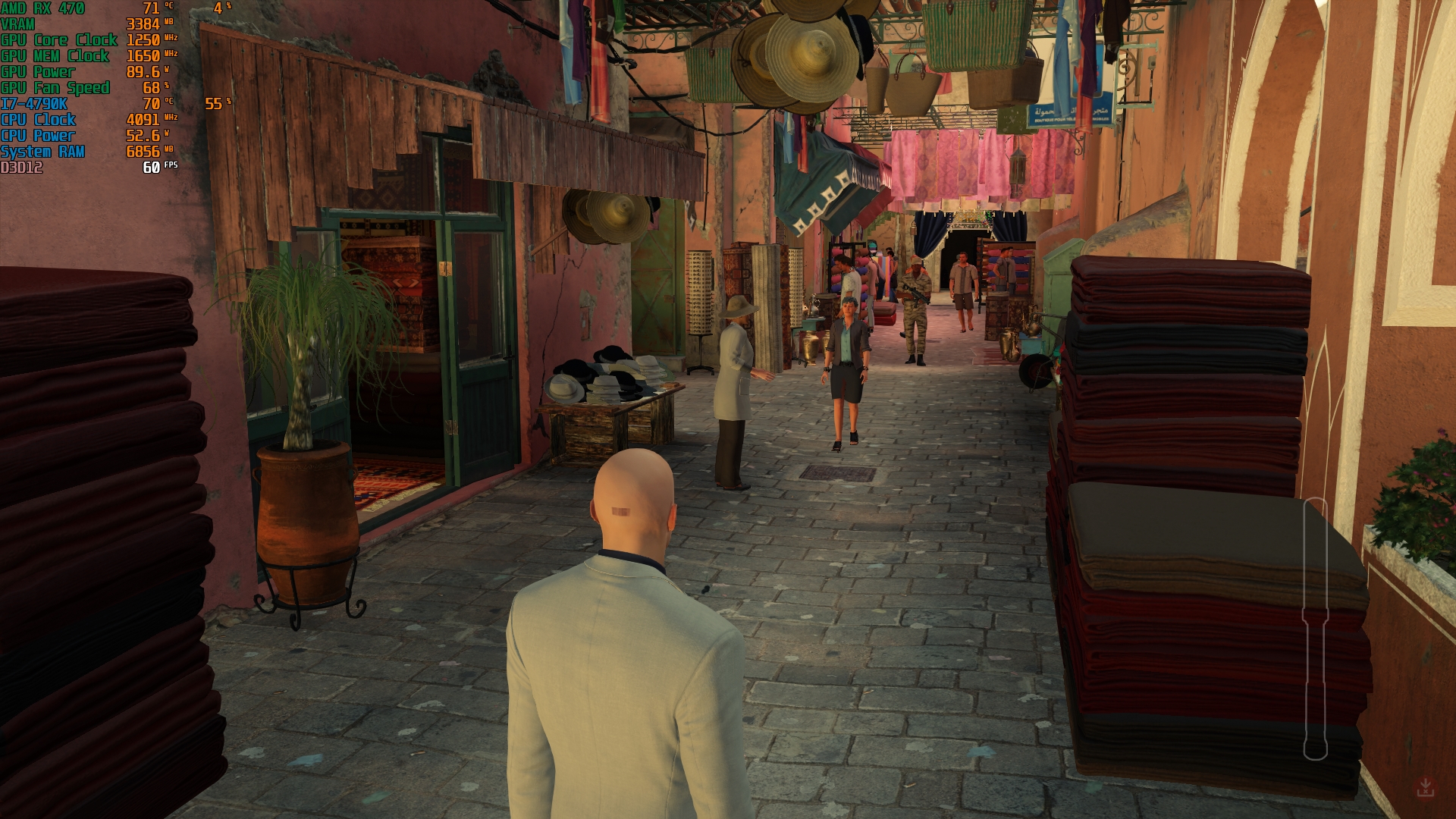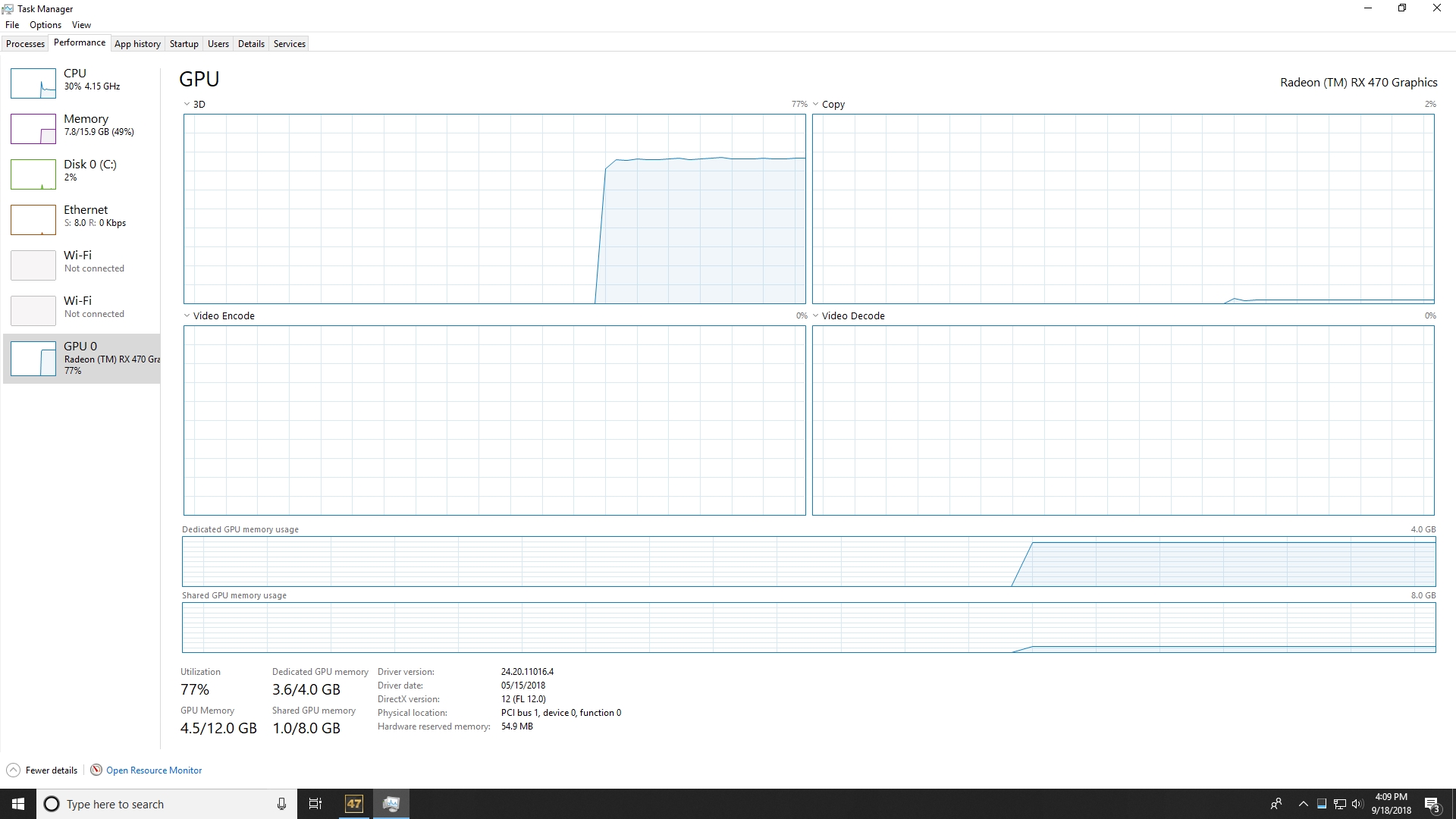- Mark as New
- Bookmark
- Subscribe
- Mute
- Subscribe to RSS Feed
- Permalink
- Report Inappropriate Content
AMD performance monitoring is not accurate
According to AMD, Hitman (2016) used up to 6 gbs as vram, but according to computer techs I spoke with, this is impossible since I have a 4 gb GPU. If the monitor is connected to the GPU, it would never use shared memory, only the dedicated memory on the GPU. MSI Afterburner seems to closely reflect this. Both of them can't be right, either Afterburner is wrong, or AMD is wrong.
AMD:

Afterburner:

Solved! Go to Solution.
- Mark as New
- Bookmark
- Subscribe
- Mute
- Subscribe to RSS Feed
- Permalink
- Report Inappropriate Content
It's why it's listed in task manager like it is, though as you can see the "shared GPU memory" of mine is 8GB. As for what the page file has to do with it, graphical assets are generated as they are needed, such as when you load a map area or level, and then when you move to another area or level, the unneeded assets are shifted out of fast VRAM and into the page file, or actually first into RAM if you have the space because it's not 2005 anymore and we all have more than 4GB of the stuff, and then into the page file if you run out of allocated RAM, as it is far quicker than having to generate them all over again.

- Mark as New
- Bookmark
- Subscribe
- Mute
- Subscribe to RSS Feed
- Permalink
- Report Inappropriate Content
Page file usage also counts as VRAM usage in some programs, since unneeded graphical items are stored there for quick access if they are needed again. The size dedicated to it is usually half your video card's memory.
- Mark as New
- Bookmark
- Subscribe
- Mute
- Subscribe to RSS Feed
- Permalink
- Report Inappropriate Content
But why count it if it isn't relevant to the game itself? There should be a separate section for page file usage and another for video ram. It had me assuming I was using shared memory or something when it actually isn't at all. What does page file usage have to do with video games?
- Mark as New
- Bookmark
- Subscribe
- Mute
- Subscribe to RSS Feed
- Permalink
- Report Inappropriate Content
I get what you are saying it really is more the texture size being used which is more than the card has. It isn't wrong, it just spills over to other memory when it runs out. Not necessarily a page file either if plenty of system ram is available it can be there too. In reality if you were going to document where every piece of information is at any given time in the process, your performance monitor would probably need a bigger screen than your game. Sounds like one is really reporting how much ram is being asked for based on texture size (and anything else that goes to vram) and the other is showing how much is actually being used on the card, both are likely right in their own way.
Now a page file and video games. The game will write textures to the Video Cards VRAM, if it runs our it will write to the systems ram, SDRAM. When you run out of system ram, the system will page to disk, either a SSD (faster) or spinning disk (way slower) if that is still what you use. So when it comes to a Game it goes to VRam, if you don't have enough, it will write to you SDRAM (system memory) if that happens and your are then out of system SDRAM the system will decide what it then pages to the page file.
- Mark as New
- Bookmark
- Subscribe
- Mute
- Subscribe to RSS Feed
- Permalink
- Report Inappropriate Content
Ok, so AMD's performance monitoring is the one reporting how much ram is being asked for while MSI Afterburner reports how much is actually being used?
- Mark as New
- Bookmark
- Subscribe
- Mute
- Subscribe to RSS Feed
- Permalink
- Report Inappropriate Content
Yes and yes maybe. Afterburner is only showing how much of the GPUs memory is being used, not how much memory is being used in total by the game, which is what thee performance monitor is showing. Does that make sense?
- Mark as New
- Bookmark
- Subscribe
- Mute
- Subscribe to RSS Feed
- Permalink
- Report Inappropriate Content
I see, so would getting a GPU with 8 or more gb of video ram matter at all? How about 12 gbs of vram?
- Mark as New
- Bookmark
- Subscribe
- Mute
- Subscribe to RSS Feed
- Permalink
- Report Inappropriate Content
Of course it matters. If it it didn't it wouldn't be offered. The more it can process on the card the faster it is as it doesn't involve secondary hardware it does not need to.
- Mark as New
- Bookmark
- Subscribe
- Mute
- Subscribe to RSS Feed
- Permalink
- Report Inappropriate Content
Ok, it really makes me wonder because it never reported vram use above 4 gbs before I changed the priority setting of the games exe file to 'high'. My newer games haven't crashed since, so my PC obviously wasn't doing what it was supposed to do with high performance programs like video games.
- Mark as New
- Bookmark
- Subscribe
- Mute
- Subscribe to RSS Feed
- Permalink
- Report Inappropriate Content
It isn't going to change the memory size based on being high priority. That is based purely on the graphical settings in the game. Most games don't tell you what they are using anyway. A few games of late now do.
- Mark as New
- Bookmark
- Subscribe
- Mute
- Subscribe to RSS Feed
- Permalink
- Report Inappropriate Content
This seems like a case of the PC saying "I wish the GPU can use more ram, but since you don't have the space, I'll just look elsewhere". If its asking for more video ram than the GPU can provide, then it makes me wonder why Nvidia and AMD markets these 4 gb cards as if its enough for the more graphically demanding video games when it clearly isn't. 6 gigabytes should be the new standard at the very least, and no less than that. These games will have 4 gbs for breakfast if given the chance.
- Mark as New
- Bookmark
- Subscribe
- Mute
- Subscribe to RSS Feed
- Permalink
- Report Inappropriate Content
In reality their are still very few games that require more than 4gb of vram. Even the ones that will use more can typically be adjusted to operate fine within that 4gb buffer. Not everyone can afford a top end card so there are choices at every price point that allow people to get a gaming card. There is no doubt though that 4gb should be an minimum these days and that will probably become obsolete much quicker with coming AAA titles than the 2gb to 4gb era cards did. I think this is where AMD does do their customers well. They have many cards with 8gb offerings. Where Nvidia will do 6gb at that same price point. This is one of the main reasons an RX 580 is so much better at 1440p than a 1060 6gb is IMHO.
- Mark as New
- Bookmark
- Subscribe
- Mute
- Subscribe to RSS Feed
- Permalink
- Report Inappropriate Content
It's why it's listed in task manager like it is, though as you can see the "shared GPU memory" of mine is 8GB. As for what the page file has to do with it, graphical assets are generated as they are needed, such as when you load a map area or level, and then when you move to another area or level, the unneeded assets are shifted out of fast VRAM and into the page file, or actually first into RAM if you have the space because it's not 2005 anymore and we all have more than 4GB of the stuff, and then into the page file if you run out of allocated RAM, as it is far quicker than having to generate them all over again.

- Mark as New
- Bookmark
- Subscribe
- Mute
- Subscribe to RSS Feed
- Permalink
- Report Inappropriate Content
Yeah, I see that the game actually is using shared GPU memory in my task manager while playing games. So it uses page file memory and system ram, whatever it takes to keep the game running smoothly apparently. This explains why game companies will always recommending at least 16 gbs of system ram for the most demanding games. It was using at least 1 gb of shared memory while playing Hitman for instance, the rest of that may have been page file memory.

